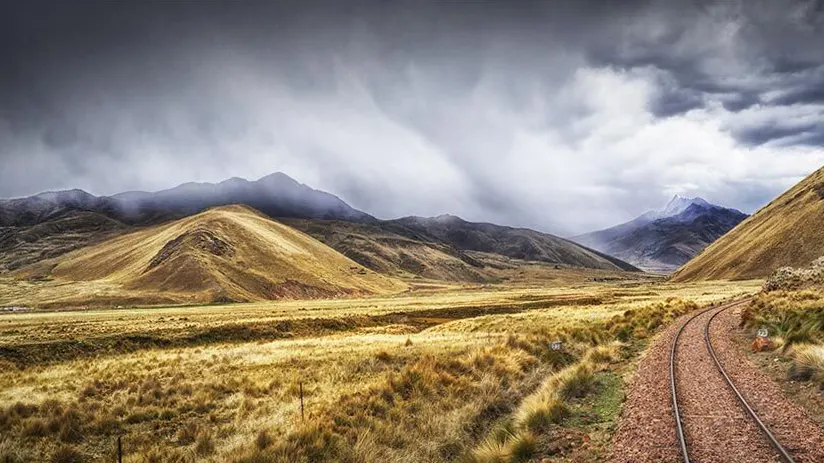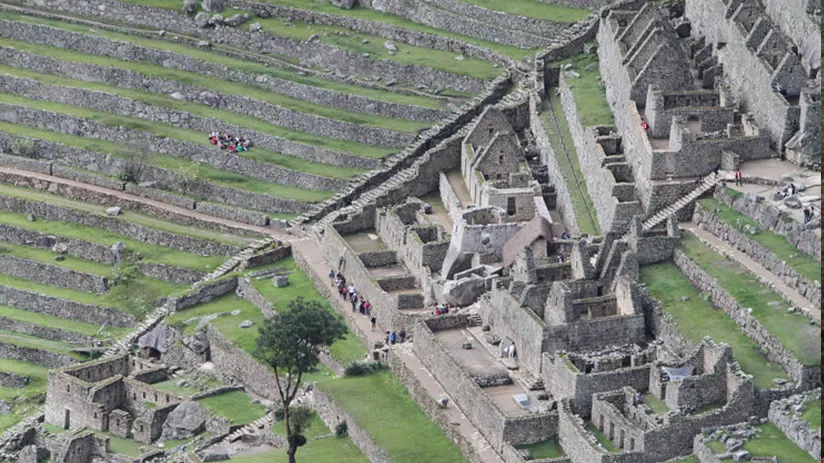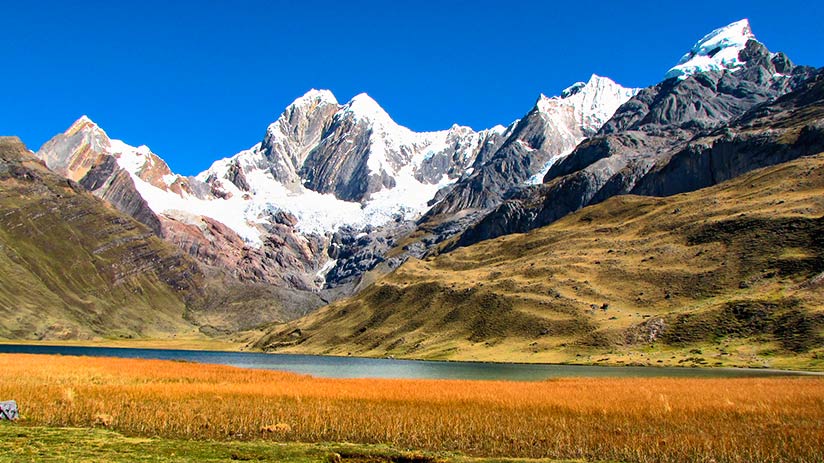The Andean region is one of the most desired paradises for adventurers and explorers visiting the country. Within this extensive region, you can find numerous Inca ruins, some older than the Inca empire itself.
The Peruvian Andes offer some of the most incredible landscapes in Peru, with some of the highest mountains in the country and surprising valleys of great beauty. Not in vain did the Incas choose this place as the epicenter of their great Empire since they considered the surrounding areas sacred. With the travel experts of Machu Travel Peru, we have decided to write about this incredible region and what you can do there.
It is one of the most incredible destinations to explore on your next vacation.
Location

The Peruvian Andes, part of the extensive Andean mountain range that stretches along the western edge of South America, run north to south through Peru and encompass a variety of regions and cities. This area is characterized by dramatic elevation changes, with peaks reaching over 6,000 meters, including Huascarán, the highest mountain in Peru.
Major towns within this region include Cusco, the historic capital of the Inca Empire; Puno, located on the shores of Lake Titicaca, the highest navigable lake in the world; Arequipa, known for its colonial architecture and the nearby Colca Canyon; and Huaraz, a hub for trekking and mountaineering in the Cordillera Blanca. The Andes significantly influence Peru’s climate and ecosystems, creating diverse environments from lush cloud forests to arid highlands. The region is rich in cultural and historical significance, with numerous archaeological sites, including the iconic Machu Picchu, attracting visitors from around the globe.
Weather

The climate in the Andes is as diverse and dynamic as its landscapes, which greatly influences tourism in Peru. The Andes, which extend over various altitudes and latitudes, experience different climatic conditions, offering something unique in each season and region. In addition, you will find two marked seasons, which we will explain.
The dry season
The dry season is considered the best time to visit from May to October, offering clear skies and ideal conditions for trekking and outdoor activities. Many tourists were eager to explore famous trails like the Inca Trail and iconic sites such as Machu Picchu during this period.
The wet season
From November to April, the wet season brings more frequent rains, making travel and hiking more challenging and bringing the landscapes to life with lush greenery and blooming flowers. During this time, tourists can enjoy fewer crowds and different natural beauty like cloud forests.
The weather patterns are as varied and captivating as the scenery, enhancing the tourism experience in Peru. Whether basking in the warm sun of a highland village or experiencing the misty rain of the Amazonian slopes, the climate of the Andes enriches the richness and beauty of this remarkable region, making it a prime destination for travelers seeking diverse and unforgettable experiences.
Where to go
Peru is part of the Central Andes, a region that can be explored on beautiful walks to Machu Picchu, excursions to the Sacred Valley, and folkloric destinations such as Lake Titicaca. This place is one of the favorite regions in Peru, and you can enjoy numerous tours there.
The enigmatic Sacred Valley, Located just north of Cusco, is a region of fertile lands, traditional villages, and impressive Inca sites. The valley has a pleasant climate and scenic beauty.
The Sacred Valley, located just north, has fertile lands, traditional villages, and impressive Inca sites. The valley’s pleasant climate and scenic beauty make it ideal for trekking, horseback riding, and exploring ancient ruins such as Ollantaytambo and Pisac. The local markets offer a glimpse into the vibrant Anden Culture.
Cusco

We believe the Imperial City is one of the leading destinations in the country. The ancient capital of the Inca Empire is a real sight to behold. Inside, you will be able to appreciate numerous exemplary architectural constructions of the particular style of Cusco.
You will also enjoy a city rich in cultural nuances, delicious cuisine, and innumerable tourist attractions. The Incas did not choose Cusco as the capital of their Empire in vain, so you cannot miss out on this destination, which was representative of the Andes.
Sacred Valley

The Sacred Valley of the Incas is one of the most popular after the beautiful city of Cusco. The Valley encompasses numerous picturesque towns and endless outdoor activities to keep even the most energetic tourists busy. You can enjoy horseback riding through the valley and its mountains and other adrenaline-pumping activities such as rafting and zip-lining. Even if you’re looking for romantic getaway destinations, the valley offers some of the most dreamy scenery.
Lake Titicaca

The highest navigable lake in the world is home to some of the most interesting alternative cultures. The different communities in and around it continue to maintain ancestral traditions. You can visit the many ruins and vestiges of ancient civilizations in their surroundings and meet and participate in the life of the different communities. There are many options to enjoy one of the most popular areas.
What to do
Fortunately for those who love outdoor activities, the Andes is one of the leading destinations for adventure tours. If you are planning a trip to Peru, the Andean region is an unmissable destination where you can enjoy numerous attractions and tours that are full of history.
Hiking

If you are an adventure lover searching for new challenges and sensations, the Andes are for you. You can find endless hiking trails to discover the impressive landscapes throughout the region. The Andes mountain range is quite long so that you will have a hundred routes, towns, and areas at your disposal. And if you are new to the hiking world, don’t worry; you will find many hikes for beginners. Here are some of the best options:
- Sacred Valley: offers several hiking routes that pass through Inca villages and impressive agricultural landscapes.
- Ollantaytambo: You can explore local archaeological sites and trails leading to Incan terraces and viewpoints here.
- Rainbow Mountain (Montaña Vinicunca): While it can be a short hike, it’s a moderately strenuous climb to reach the famous colorful mountain views.
Trekking

All the trekking routes in the Andes could be considered the home where numerous communities and civilizations left vestiges of their ancient cultures. In the Andes, you can find many ancient ruins, many of which belong to the Inca Empire and many others older than the Empire itself. Many of them can even be appreciated during some hiking trails. Here are some of the best options:
- Inca Trail to Machu Picchu: One of the most famous treks in the world, combining Incan history with stunning landscapes. It typically takes 4 to 5 days.
- Ausangate Trek: Known for its turquoise lakes and views of the Ausangate mountain, this trek is more remote and less traveled.
- Santa Cruz Trek: Located in the Cordillera Blanca, this more accessible and popular trekking option offers spectacular views of snow-capped peaks, glacial lakes, and an incredible highest peak called “Abra of Salkantay”.
- Huayhuash Circuit: Renowned for its dramatic scenery and challenging mountain passes, this circuit is ideal for experienced hikers seeking a challenge. (The most extended continental mountain range).
- Choquequirao Trek: Locate in the Cordillera de los Andes range. Similar in architecture to Machu Picchu but less visited and more remote. It’s a choice for those looking to explore lesser-known ruins.
Visiting Sacred and Archaeological Sites

Exploring the sacred and archaeological sites offers a journey into the heart of ancient civilizations and the natural beauty that shaped their lives. The most important ruins to visit in Peru are Machu Picchu, Ollantaytambo, Sacsayhuamán, and Pisac, which not only showcase advanced engineering and cultural richness but also provide a profound connection to the spiritual and historical legacy of the Andean peoples.
Visiting these places allows travelers to marvel at meticulously crafted stone structures, terraced agricultural systems, and ceremonial plazas, offering a glimpse into the ingenuity and artistic prowess that defined life in the Andes centuries ago.
Reasons to visit the Peruvian Andes
We believe there are few places where you can wake up to dream landscapes with amazing people, delicious food, and a culture that persists over time. The Andes represents this for us: a place where time has no effect and happiness is always present. And among the many reasons to visit them, you can find the following.
The food

One of the most incredible aspects is its unique gastronomy. The Andes were the birthplace of the potato, one of the most coveted foods in the world. And part of our heritage boasts more than 3,800 different types of potatoes. Its cuisine continues to be the focus of great trends emerging in the culinary scene. If you visit Peru, you must try the delicious Andean cuisine.
The Culture

Traditional culture permeates the Andean country’s towns, cities, and communities. The great diversity of people and ethnic groups has given rise to a unique culture that continues to live despite constant globalization. This culture reflects the beliefs and social structures that makeup Peru. It can be seen in dances, traditional Peruvian clothes, architecture, music, etc.
Tourism in Peru, particularly in the Andean region, offers a rich tapestry of cultural and natural experiences that are truly captivating. The Andes, with their diverse landscapes ranging from lush valleys to towering peaks, provide a backdrop for exploring ancient civilizations like the Incas. Cities like Cusco and Machu Picchu showcase remarkable archaeological treasures and immerse visitors in a living cultural heritage spanning millennia.
The blend of indigenous traditions with Spanish colonial influences creates a unique cultural mosaic in everything from architecture to cuisine. Trekking through the Andes offers physical adventure and a deep connection to nature and history. Preservation efforts and sustainable tourism initiatives in places like Urubamba, Calca, and the entire Sacred Valley map highlight a commitment to protecting these invaluable cultural and natural resources for future generations.
Overall, tourism in Peru’s Andean region provides economic opportunities and fosters cross-cultural understanding and appreciation. It’s a journey that combines awe-inspiring landscapes with profound historical insights, making it a must-visit destination for travelers seeking adventure and cultural enrichment.
The people

Within Peru, you will not only find beautiful destinations and attractions, but the people you meet are also a big part of the experience. And the truth is, these destinations would be nothing without their inhabitants.
The people of Peru, known as Peruvians or locals, are incredibly diverse and reflect a rich tapestry of cultural influences shaped by centuries of history. Peruvians are known for their warmth, hospitality, and a strong sense of community, often expressed through traditional clothing in Peru, colorful festivals, traditional music, and culinary delights such as ceviche and pisco sour.
Modernity blends seamlessly with ancestral traditions in urban areas such as Lima and Cusco, creating a dynamic cultural landscape where ancient ruins coexist with bustling markets and contemporary art scenes. Despite regional and cultural differences, Peruvians share a deep pride in their heritage and a resilience shaped by their diverse history, making interactions with locals a rich and rewarding experience for visitors exploring this diverse country.
The scenery

One of the main reasons to visit this place is its indescribable landscapes. As it has a vast territory, it would not be surprising if there were some hidden places among its sceneries.
Otherwise, the biodiversity in Peru evokes a deep sense of awe and inspiration. The sheer diversity, from the arid coastal deserts to the towering Andean peaks and the vibrant Amazon rainforest, paints a picture of nature’s boundless creativity and resilience. Each ecosystem’s unique flora and fauna tell a story of adaptation and coexistence, reflecting millennial evolution and the intricate life balance on Earth.
Frequently questions
When is the optimal season for trekking or visiting the Andes?
The best time to visit is during the dry season, which runs from May to September. These months offer clearer skies and lower rain chances, ideal for trekking and exploring archaeological sites.
How do you acclimatize properly to avoid altitude sickness?
Altitude sickness can be a concern when visiting the Andes, especially if you’re not acclimatized. Before heading to higher altitudes, a day in Cusco (3,400 m./ 11,154 ft.) above sea level is recommended. Drinking plenty of water, avoiding alcohol, and eating light meals can also help mitigate symptoms.
What cultural sites or local experiences are recommended beyond Machu Picchu?
Beyond Machu Picchu, consider visiting lesser-known archaeological sites like Ollantaytambo, Pisac, and Moray. Engaging with local communities, visiting markets (like in Pisac), and attending traditional festivals can also provide authentic cultural insights.
What should we pack for the travel?
When packing for a trip to Peru, particularly to the Andes, it is important to consider the region’s climate, terrain, and altitude. Here are some essential items to pack: layered clothing, hiking pants and shorts, insulating layers, moisture-wicking socks, hiking boots, Gloves, a hat, a scarf, and at least no important sun protection.
What unique plants and animals can be encountered in the Andean region?
The Andean region has unique flora and fauna, including llamas, alpacas, andean condors, andean cock of the rock, and spectacled bears. You may also encounter a variety of high-altitude plants, such as bromeliads, orchids, and the iconic Puya Raimondi, the world’s largest bromeliad.
With so many natural gems to discover, what are you waiting for to organize your next vacation?
“IF YOU NEVER LEAVE HOME, NEVER LET GO. YOU’LL NEVER MAKE IT TO THE GREAT UNKNOWN”
We hope that, together with the travel experts of Machu Travel Peru, we have helped you understand everything you can do in the Peruvian Andes. If you want to know more about our tours of the Highlands, do not hesitate to ask our travel advisors.
